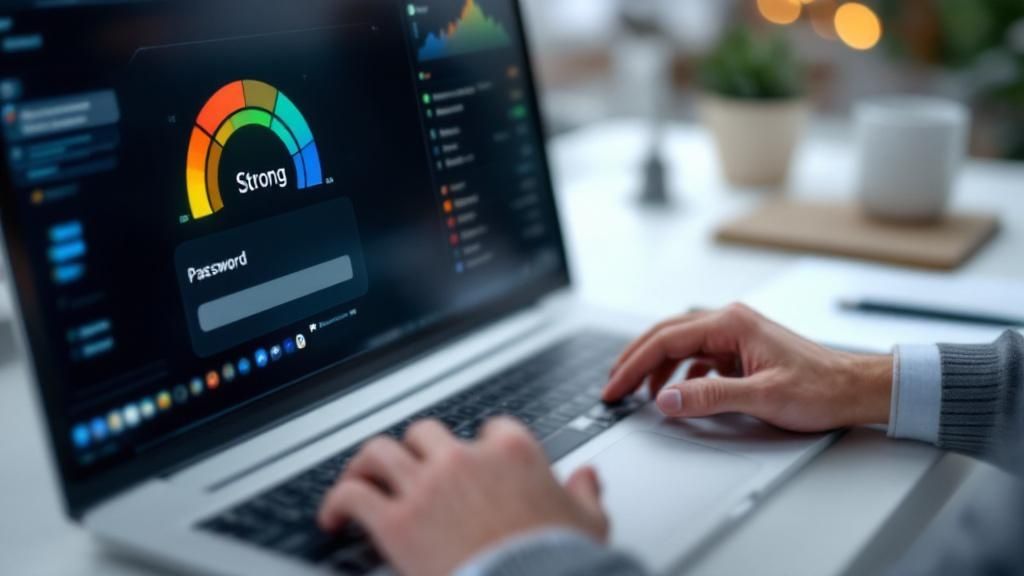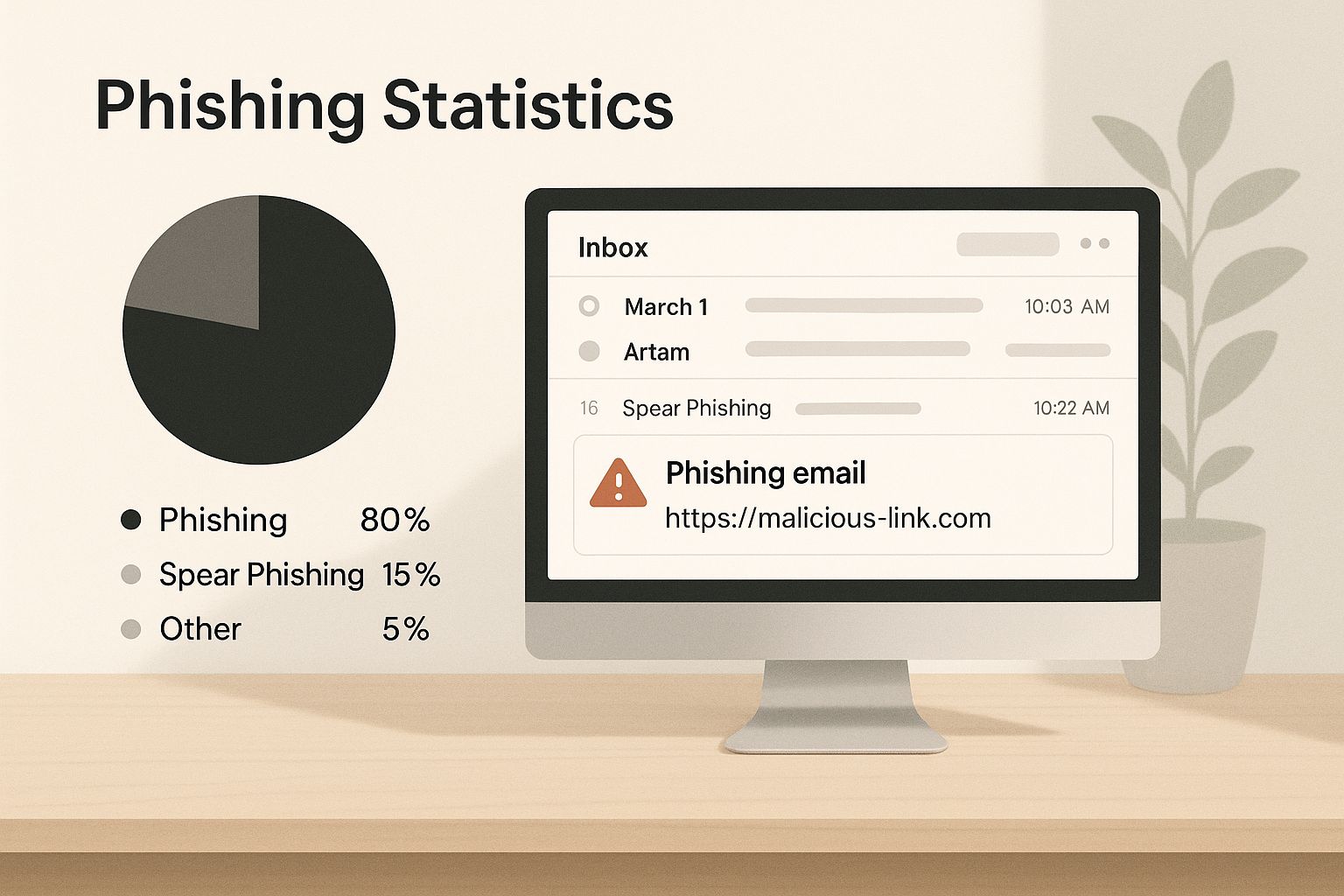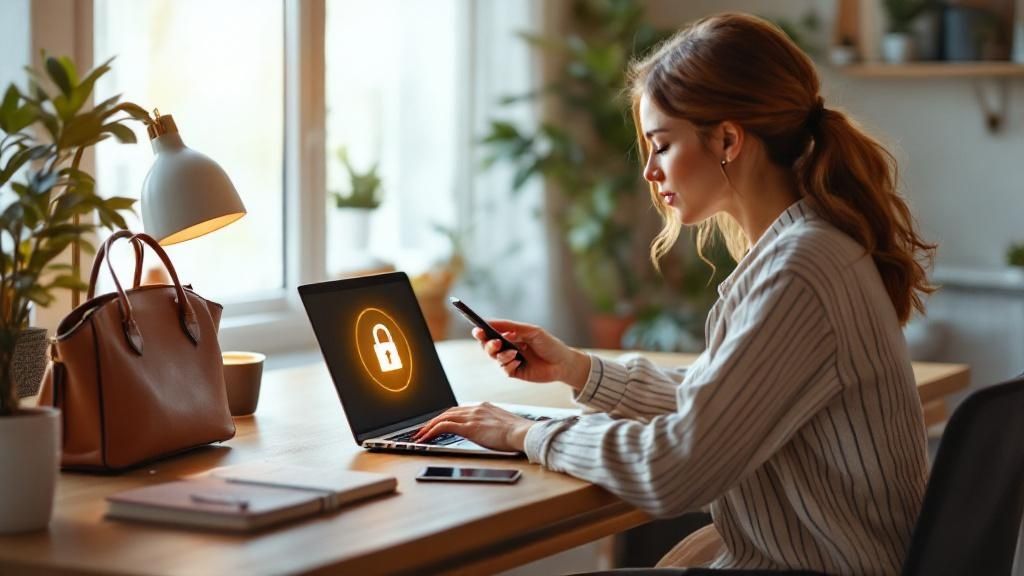Why Your Current Shopping Habits Might Be Putting You at Risk

Let's be honest, online shopping has become a lifeline. But what felt safe a few years ago might not be cutting it anymore. I've been chatting with fraud investigators, and the stories they tell are enough to make anyone think twice. These aren't your average phishing scams; we're talking sophisticated operations that could trick even the most tech-savvy shoppers.
For example, I recently heard about a grandmother who lost £800 on a fake designer handbag site. The site was a perfect clone of the real deal – even the reviews seemed legitimate. It really highlights how the old red flags just don't cut it anymore. Criminals are upping their game, which means we have to as well.
And it's not just about individual scams. The sheer volume of online shopping creates a massive target. Think about it: online sales now make up over 27% of all retail sales in Great Britain. That’s more than a quarter of all purchases happening digitally. With an e-commerce penetration rate close to 85%, nearly nine out of ten UK adults shop online. This makes understanding online safety even more critical. Want to dive deeper into these trends? Check out this article: Discover more insights.
Now, I'm not trying to scare you off online shopping. Sites like TheFeinheit.com offer amazing convenience. This is about giving you the tools to spot those hidden vulnerabilities that fraudsters love to exploit. It's like a security upgrade for your online shopping experience. In the next sections, we'll unpack how to identify and avoid everything from fake reviews to cloned websites.
Let's take a look at the growth of UK online shopping alongside the increasing security risks in this table:
To illustrate this point, I’ve compiled some current data on UK online shopping and related security issues.
UK Online Shopping Growth vs Security Threats
| Metric | Current State | Security Impact |
|---|---|---|
| E-commerce Penetration Rate | ~85% | Increased potential victim pool for scams |
| Online Retail Sales as % of Total Retail Sales | >27% | Higher transaction volume creates more opportunities for fraud |
| Mobile Commerce Usage | Increasing | Mobile devices can be more vulnerable to security breaches |
| Social Media Shopping | Growing Trend | Increased risk of encountering fraudulent ads and counterfeit products |
This table really emphasizes the need for increased vigilance. While the convenience of online shopping, especially through mobile and social media, is undeniable, it also presents new challenges. The more we shop online, the more important it becomes to be aware of these potential threats.
Separating Legitimate Retailers From Elaborate Scams

This screenshot from a UK government report shows just how much thought goes into online shopping decisions. It’s fascinating how many factors play a role when we’re sizing up a website – security is just one piece of the puzzle. It’s more about a gut feeling of whether a retailer is the real deal. And that's exactly why scammers who put so much effort into mimicking legitimate businesses can be so successful. They know how to exploit our trust.
I almost learned this the hard way. I nearly fell for a fake electronics site that looked incredibly convincing. Spotting these phony shops is a real skill these days. The really dangerous ones don’t rely on obvious tricks anymore. They’ll have everything from SSL certificates (that little padlock in your browser) to a slick, professional design.
So, what gives them away? The devil is in the details. Established businesses, particularly luxury retailers like TheFeinheit.com, have telltale signs of authenticity. Look closely at their contact information, returns policies (which should align with UK consumer law), and customer reviews. A genuine UK retailer will always mention your statutory rights under the Consumer Contracts Regulations. For a clear example, have a look at our own Terms and Conditions. These small but crucial details are what scammers often overlook.
With the rise of online shopping in the UK, staying alert is more important than ever. Understanding how people shop online, especially when it comes to safety, is a big deal. The UK government is even researching it – you can dig into their findings here.
How do you stay safe? Think like a fraud investigator. They have their tricks: checking Companies House registrations (easy to do online via Companies House), digging into domain registration details, and scrutinizing customer service responses. These are the things that separate the real from the fake, and these checks can save you from a costly mistake. You’ll quickly get a feel for how genuine UK customer service operates, what your rights are, and how to spot those warning bells.
Choosing Payment Methods That Actually Protect You

This infographic shows how a phishing scam might land in your inbox. It's a good reminder that threats lurk everywhere, even on sites that look totally legit. That warning icon? It's a visual cue to stay sharp. Trusting a retailer isn’t enough; you also need to be smart about how you pay. Speaking of shady sites, these phishing email examples show some common tricks scammers use. Honestly, after looking at tons of fraud cases, I've learned that your payment method can be the difference between a small headache and a financial disaster.
Most people don't realize that some payment methods offer way better protection than others. The wrong choice can actually make you more vulnerable. I’ve chatted with banking security experts who've seen how quickly credit card users get their money back – sometimes within 48 hours. Meanwhile, someone who used a debit card might wait months. This has nothing to do with the retailer; it's about the built-in protections of each payment system. Criminals know this and often target certain payment types, exploiting weaknesses in methods that seem safe. For example, bank transfers feel secure, but there’s little you can do if you get scammed. Even digital wallets, despite their convenience, have specific dispute processes you need to understand.
Let’s break down the key differences between credit cards, debit cards, PayPal, Apple Pay, and other UK payment options. I’ll offer specific advice for different situations. Check out our Privacy Policy to see how we protect your payment info. Plus, I'll share some common payment mistakes even careful shoppers make, and how you can stay as safe as possible, no matter how you prefer to pay. Knowledge is power, right?
Payment Method Security Comparison
To help you see the differences at a glance, I've put together this comparison table. It breaks down the security features and fraud protection you get with various payment methods.
| Payment Method | Fraud Protection | Dispute Resolution | Risk Level |
|---|---|---|---|
| Credit Card | Excellent, strong consumer protection laws, chargebacks usually easy | Fast and efficient, usually resolved within days | Low |
| Debit Card | Moderate, some protection but depends on bank policies | Slower and more complex, can take weeks or months | Medium |
| PayPal | Good, buyer protection program offers some coverage | Relatively quick, usually resolved through PayPal's dispute center | Medium |
| Apple Pay | Excellent, utilizes tokenization for added security, linked to credit card benefits | Similar to credit card, fast and efficient | Low |
| Bank Transfer | Poor, very little recourse in case of fraud | Very difficult, often irreversible | High |
As you can see, credit cards and Apple Pay offer the best protection, while bank transfers are the riskiest. Choosing wisely can save you a lot of trouble down the line.
Shopping Internationally Without Getting Burned
Buying luxury goods from overseas opens up a whole world of exciting finds – but it also has its own set of challenges. From personal experience, and through conversations with customs officials and fraud specialists, I’ve learned a thing or two about navigating the international shopping scene. It’s more than just dealing with different languages or waiting for weeks for your package to arrive.
I've heard horror stories about currency conversion scams that leave shoppers paying exorbitant amounts, far beyond what they initially agreed to. Counterfeit goods are another major issue. I've personally seen fakes so convincing they could fool almost anyone – until they fall apart after a few uses or, even worse, present a safety hazard.
And if you do run into problems? The consumer protections you enjoy in the UK might not apply when shopping abroad. Imagine the headache of trying to return a faulty item to a retailer in another country. Just the shipping costs alone can be a nightmare! That’s why it's so important to know how to protect yourself when shopping safely online from international sellers.
Cross-border e-commerce is definitely on the rise in the UK. In 2025, cross-border sales for UK retailers climbed 4%, slightly behind the overall EMEA region's 6% growth. This increasing globalization makes online shopping safety more crucial than ever. Discover more insights. Also, you might find this helpful: Import Taxes and Customs Duty Policy.
So, how can you snag those unique international treasures without the stress? I’ll share some real-world experiences from UK shoppers who've mastered the art of international online shopping. We’ll cover everything from thoroughly checking out international sellers and selecting secure payment methods to spotting the red flags of international scams. I’ll also share some insider tips on handling import duties, dealing with lost packages, and navigating the complexities of international returns. It's all about getting the most out of your global shopping adventures while keeping your risks to a minimum.
Securing Your Shopping Accounts Like a Security Professional
Your online shopping accounts hold a lot more than just your credit card number. They're a goldmine of personal info: past purchases, your home address, even enough details for a thief to steal your identity. After looking into data breaches, I've realized most of us don't grasp how valuable this data is to criminals. But relax, you don't need to become a cybersecurity whiz to shop safely.
One of the easiest and most effective things you can do is turn on two-factor authentication (2FA). I get it, it can be a bit annoying, but believe me, it's a game-changer. Think of 2FA as adding an extra lock to your front door. It's like having a guard check IDs before anyone gets in. Most sites offer 2FA via an app or text message. Set it up now – you won't regret it. For more on how we handle security, check out Feinheit’s Shipping Policy.
Password Strategies That Actually Work
While we're on the subject of security, let's talk passwords. Using the same password for all your accounts is a major security risk. It's like using one key for your house, your car, and your office. If someone gets that key, they have access to everything. I personally use a password manager. It's like having a high-security safe for all your passwords, and you just need to remember one master key.
Also, pay attention to what information you're giving retailers. Name, address, and payment info are standard, but be careful about anything extra. If something seems off, go with your gut. A legit UK retailer won't need your mother's maiden name or national insurance number just to send you a package.
Recognizing a Compromised Account
Lastly, it's important to know the warning signs of a hacked account. Things like surprise password changes, order confirmations for things you didn't buy, or weird login activity are all red flags. If anything looks suspicious, change your password right away and contact the retailer's customer service. It's like checking your bank statements regularly–you can catch issues early. These simple steps can drastically lower your risk so you can shop online confidently, knowing your info is safe.
Handling Shopping Disasters Like a Pro
Online shopping, even for luxury items, can sometimes go sideways. Maybe that "must-have" designer bag arrives looking suspiciously like a knock-off, or unexplained charges appear on your credit card statement. Trust me, I’ve been there. Those initial few hours after discovering a problem are crucial. What you do then can make all the difference between a quick resolution and a total shopping nightmare. I’ve picked up a few tricks, some from experience (ouch!) and others from consumer protection experts, that really work.
First things first: documentation is key. Think of it like building a case. Screenshot everything: the product page, your order confirmation, and especially any fishy-looking emails. The more evidence you gather, the stronger your position will be. Knowing exactly who to contact first—your bank or the retailer—saves valuable time. For example, dealing with potentially fraudulent charges on your card requires a completely different approach than a simple return. I've even created some template letters you can adapt to make contacting the right UK authorities less intimidating. Need a quick refresher on UK return policies? Check out this helpful guide: Return and Refund Policy.
Knowing Your Rights and Escalating Effectively
We’ve all heard it before, but strong passwords are your first line of defense. Treat your online shopping accounts like Fort Knox. Use a password manager if it helps, and activate two-factor authentication wherever possible, like you see on many login pages these days: Account Login.
Surprisingly, many shoppers aren’t clear on their consumer rights in the UK. The Consumer Rights Act 2015, for example, gives you significant legal backing if you receive faulty goods. Knowing your rights gives you the confidence to push back when necessary.
Sometimes, social media can be surprisingly effective. It’s not just about venting (though that can feel good!). A well-crafted post on a retailer’s Facebook page can sometimes work wonders when standard customer service channels fail. It’s worth a shot, especially if you feel you’re getting nowhere.
This screenshot shows the reporting portal for Action Fraud, a crucial resource if you think you’ve been scammed. Their site is a goldmine of information on recognizing and reporting different types of fraud. Having reliable resources like this bookmarked can be invaluable.
Learning to shop safely online isn’t just about prevention; it’s also about knowing what to do when things go wrong. By being prepared and informed, you can handle nearly any online shopping disaster like a seasoned pro.
Your Complete Safe Shopping Action Plan
So, we've covered the risks and how to protect yourself. Now, let's create a practical plan you can actually use. This isn't about rigid rules, but about developing smart online shopping habits. Think of it as leveling up your security game.
Quick Checks for Everyday Purchases
For everyday items, a few quick checks can make a world of difference. Before clicking "add to cart," pause and:
- Look for the padlock icon in your browser's address bar. This indicates the site uses HTTPS, which encrypts your information.
- Browse customer reviews for anything suspicious. Too many glowing reviews, or ones that sound eerily similar, can be a warning sign.
- Double-check the website address (URL). Scammers often use URLs that are almost right, hoping you won't notice. Make absolutely sure you're on the real retailer's site.
These simple checks take mere seconds, but add valuable peace of mind.
Extra Caution for Big-Ticket Items
When purchasing something special, like that stunning designer handbag from TheFeinheit.com, extra caution is warranted. Besides the usual checks:
- Verify the retailer. If you're unfamiliar with the site, a quick search on Companies House can confirm they're a legitimate UK business. I've done this myself several times—especially for newer boutiques.
- Use a secure payment method. A credit card usually provides the best protection. Steer clear of bank transfers, which offer very little recourse if things go wrong.
- Document everything. Screenshots of the product page, order confirmation, and emails are your friends. This has saved me in the past!
These precautions offer strong protection for high-value buys.
Staying Ahead of the Game
The online landscape is constantly changing, with new risks emerging all the time. Staying informed doesn't have to be overwhelming:
- Subscribe to email alerts from organizations like Action Fraud. They’re great at providing up-to-date information on current scams.
- Review your bank and credit card statements regularly. It’s a quick financial health check that can catch unauthorized charges. I like to do this every few days, just to be safe.
Helping Others Shop Safely
Sharing these tips with friends and family, especially those less experienced with online shopping, is really important. Help them create strong passwords, and explain why website security matters. By empowering others, we create a safer online space for everyone.
Ready to enjoy luxury shopping with confidence? Check out the beautiful collection at TheFeinheit.com and take advantage of their free global shipping. Plus, use code LUXE5 or WELCOME10 (for subscribers) to save an extra 5%.

